News and Blog

How ASL Keeps Improving Our Seaweed Resource Assessments
This year, four of our Nova Scotia Rockweed harvesting leases came up for re-application. Acadian has been carefully managing and harvesting those government leases for over 20 years. We’ve just published a peer-reviewed scientific paper showing that the condition of the resource has remained the same over that period (read it here!).
Over the last two decades, many things have changed in the seaweed industry, one of which is the way we assess how much Ascophyllum can be sustainably harvested from each lease. There are three main components to figuring out how much can be harvested as part of our ongoing seaweed resource assessments.
1.) Using Our Knowledge of Seaweed Biology
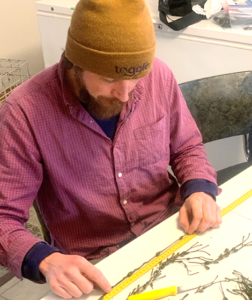
Measuring growth
First, you need to know how fast the seaweed grows. This tells us how much of it can be removed annually, also known as the harvest rate. Based on the growth rates we, and others, have observed in Southwest Nova Scotia, we’ve been harvesting at a 25% annual harvest rate (for every ton of Ascophyllum in a lease, we harvest up to 250 kg).
2.) Combining Data and Leading-edge Technology to Survey Seaweed Beds
Second, you need to know how much Ascophyllum exists in each lease and sector. This is the aspect of our job that has changed the most significantly in the last 20 years. Well, one part has not changed, we still go on the shore every summer, set up transects (paths along which we count and record occurrences of the seaweed) and measure the height and the weight of Ascophyllum in hundreds of quadrats (standardized frames for studying distribution).
These important data inform and direct our harvesting activities from year to year and, in many cases, simply confirm that the Asco is healthy and our sustainable seaweed harvesting can continue. But sometimes that’s not the case. In 2015, many of our sectors were covered in thick ice during a particularly harsh winter and we observed significant ice damage and we reduced our harvest accordingly.
Although we still conduct hundreds of surveys each year, even that part of our work has changed (for the better!). We used to write data on paper in the field, then spend part of the winter entering the data into computer spreadsheets, we now enter data directly into digital forms using the ArcGIS Survey123 App. This way, the data are automatically entered into our database and can be accessed online in real-time. Not only has this made our science team more efficient but it has greatly improved our reaction time and our ability to ensure the best management practices are being followed.
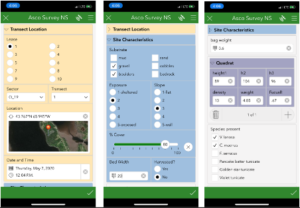
Screen grab of survey app
Measuring how much Ascophyllum is inside a quadrat is only part of the challenge. We also need to know the size of each bed. (The size of Ascophyllum beds varies greatly along the shoreline). Decades ago, individual beds would be measured with a measuring tape, more or less assuming they formed linear features along the shore. So, by measuring the width of the bed and the length of the shoreline that the bed covered, we would get an estimate of the bed area.

Later on, we improved our bedarea measurements by using aerial photographs and would hand trace what we viewed as Ascophyllum beds. It was an improvement from the previous method but because not all photographs were taken at low tide and because it can be difficult to tell what is Ascophyllum (versus mud) on some older photographs, it was not perfect. Not to mention that hand tracing each individual bed along hundreds of kilometers of coastline was laborious…
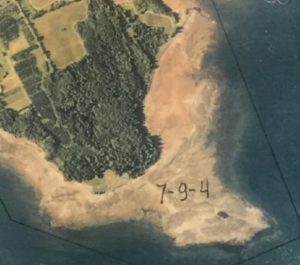
Where is the Rockweed?
So, when time came to do a complete biomass assessment for these four leases (Biomass assessments in Nova Scotia now have to be audited by a third-party), we decided the time had come to use more modern techniques. We purchased multi-spectral satellite imagery that covered our entire leases. We carefully selected imagery that was taken at low tide and on cloud-less days. Turns out that this alone was not an easy task! Normal digital cameras record red, green, and blue light and combine those three colours to produce a range of colours. Multi-spectral means that other bands (or wavelengths) beside red, green, and blue are also measured. In our case, the near infrared band (NIR) was of particular interest because while all vegetation (including seaweed) absorbs visible light for photosynthesis, it reflects most of the light in the near infra-red spectrum. This means that vegetation will appear very bright when looking at the NIR band. We can go one step further and calculate the ratio of NIR to visible light, vegetation will have high values, while everything else will have low values.
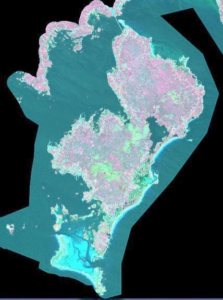
Satellite imagery of Cape Sable Island with vegetation in bright pink
So, no more trying to decide whether a section of coast is covered in mud or Ascophyllum, it is now obvious which regions are populated with seaweed. So obvious that we don’t need to hand trace the beds, but the computer can do it for us! This has two main advantages:
- The seaweed biomass assessment is much faster
- Multispectral imagery removes any subjectivity when measuring bed area.
To ensure that we are not including other vegetation (e.g., terrestrial plants) we used high-precision topographic maps to eliminate everything above the high water line.
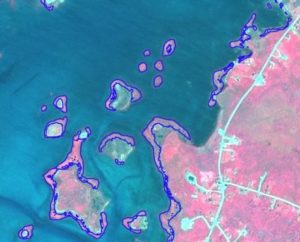
Computer assisted bed tracing
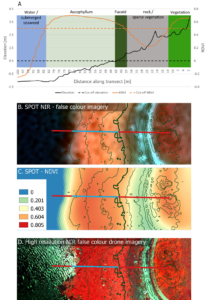
3.) Applying Decades of Resource Science Experience
Finally, we need to know which beds, and what part of each bed, the harvesters will actually harvest. If it were simple, they would be able to access everything, and our job would be much easier. But, some beds are just too exposed to waves, or are too far from landing sites (making the crossing over exposed water with a boat full of seaweed dangerous), some Ascophyllum grows on small cobbles and that makes it difficult to harvest without also harvesting a bunch of rocks, and in some beds there is not enough tall Ascophyllum to be economically harvestable. There is no simple way to calculate all this and we’ve yet to come up with a mathematical formula that would do it (but who knows one day maybe?). So, this is where our 25 years of experience really comes into play. After years of field observations and discussions with harvesters (some have been harvesting the same beds for 40 years!), we could say that we have intimate knowledge of our Asco.

Dr. Ugarte sleeping in Asco.
So, once we have done all our field work and satellite image analysis to calculate exactly how much biomass there is in each of our sectors, we take this one extra step to ensure that our harvest will be sustainable, we discount all the beds and biomass we don’t think our harvesters will access and calculate our 25% harvest rate on the biomass we know that they will target. We’re not required to take this step, we could base our harvest rates on all the Asco growing within our sectors, but that would be a less sustainable way of managing this important resource and it’s not the Acadian way.
4.) Maintaining Our Stewardship of the Seaweed Biomass
If there’s one theme that ties these main components of the biomass assessment process together, it’s good stewardship. Since long before I joined the company in 2014, there has been a commitment at Acadian Seaplants to rigorously monitoring the impact our harvesting processes and operations have upon this incredible natural resource.
Though the techniques, technology and scientific knowledge may advance over time, we’ll always use this guiding principle to ensure coastal seaweed populations remain a vibrant part of natural ecosystems while providing far-reaching benefits for communities all over the globe.
Are you eager to learn more about the work our marine scientists do to conduct seaweed resource assessments? Check out our Resource Science page to learn how their work helps conserve seaweed and their interconnected ecosystems.
Learn about our resource science
Related Articles
The Ebb and Flow of Resource Science Assessments
How ASL Contributes to the Zero Hunger Project by Boosting Plant Health
Saved by Seaweeds: their important contributions in times of crisis!
